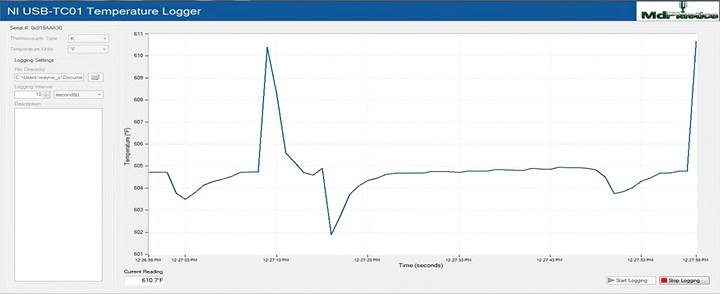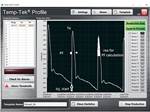Injection Molding: Making Melt Temperature A Useful Tool for Process Control
Portable, standalone data monitor replaces a laptop. Newest system uses melt thermal data to signal injection fill-to-pack switchover.
At October’s K 2019 show in Dusseldorf, Md Plastics Columbiana, Ohio, introduced two new products that are meant to take the mystery out of melt temperature in the injection barrel and make it a useful parameter for process control. Both these introductions are based on the unique Temp-Sense melt sensor marketed exclusively by Md Plastics. This bimetallic micro-bead sensor responds to both temperature and pressure, and thus measures the total “work” energy imparted to the melt during processing. (For the sake of simplicity, the control software reports the sensor data as “temperature,” though it is in fact more complex than that.) This data is said to be far more accurate and consistent than any previous method of measuring melt temperature in injection molding (see Oct. ’15 Close-Up for details).
One new product is the Temp-Sense Melt-Profiler II system, which eliminates the laptop required in the first version, replacing it with a handheld, standalone data-acquisition unit (pictured). This industrially designed unit plugs into the Temp-Sense sensor in the nozzle, and a magnet on the back allows it to be mounted on the press. Built-in software provides the same graphical displays of sensor readings throughout the process as were available on a laptop previously. Alarms can be set for peaks and integral areas of portions of the cycle curve. The unit is said to store weeks or months of operating data, which can be downloaded to a laptop or other computer system.

Peak value and area under the curve can be used to characterize a “good” cycle for process control.
The second new introduction (ready for beta testing) is the Melt-IQ system for process control based on Temp-Sense readings. The sensor is hooked up to a small box with a 5 x 7 in. display in an industrial case, which also contains a microprocessor and analog-digital conversion unit. This unit calculates peak values and integrals of areas under the “work” curve for the molding cycle at a rate of 1000 times/sec. The user sets up the unit by performing a brief trial run of a part, so that the unit “learns” the shape of the curve as the “fingerprint” of a good part. The software uses the total fill integral and the peak reading during injection to signal the transfer from fill to pack/hold. No screw position sensor is necessary, and the new system is not affected by variances in the closing of the nonreturn valve, since it measures only the thermodynamic output of the process. (It does, however, measuring injection time as a safety factor and can signal an alarm if injection time is extended beyond a preset limit.) An alarm can be actuated if the peak and integral values vary outside of set limits.
The system is designed to be competitively priced and easy to use. “It’s a unique use of temperature data,” says Md Plastics founder and president Michael Durina. “Make a good part, and the system will make sure to do it over and over again.”
Related Content
-
How to Select the Right Tool Steel for Mold Cavities
With cavity steel or alloy selection there are many variables that can dictate the best option.
-
Is There a More Accurate Means to Calculate Tonnage?
Molders have long used the projected area of the parts and runner to guesstimate how much tonnage is required to mold a part without flash, but there’s a more precise methodology.
-
How to Design Three-Plate Molds, Part 1
There are many things to consider, and paying attention to the details can help avoid machine downtime and higher maintenance costs, and keep the customer happy.








